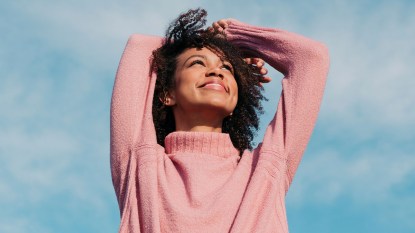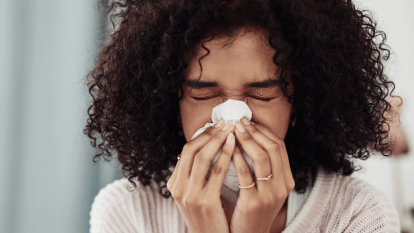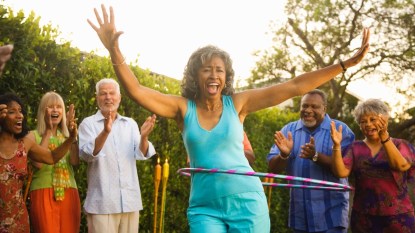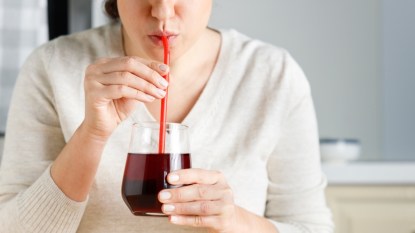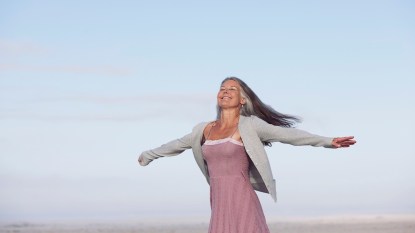Yoga for Menopause Helps Tame Hot Flashes, Irritability, Fatigue and More, Experts Agree
See the pose one yoga expert promises will leave you feel lighter and more uplifted in minutes
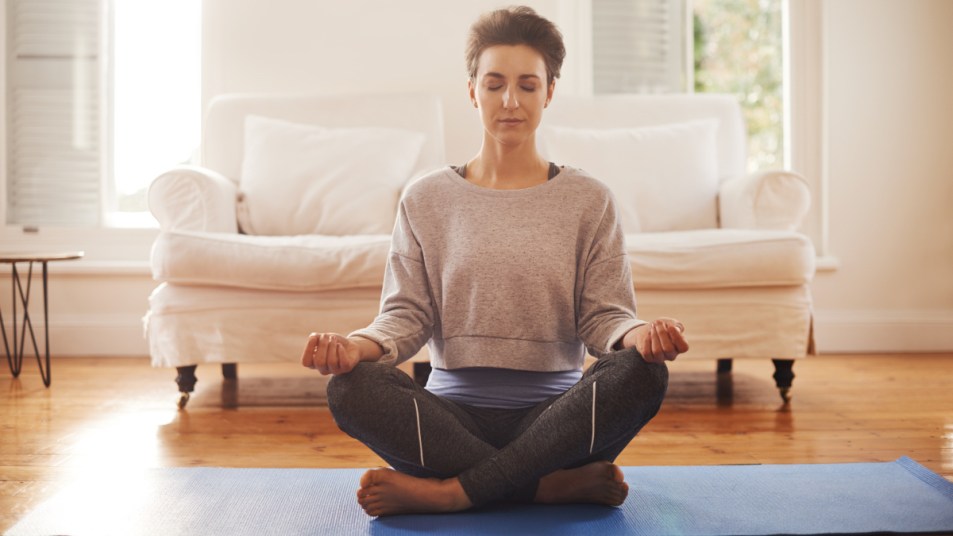
Menopause bothers like hot flashes, insomnia and irritability can sap your energy and dampen your mood. While hormone replacement therapy (HRT) and prescription medication can help, you may not be ready to try meds just yet. Or if you’re already on them, it’s possible your body needs a little extra help for stubborn symptoms. Enter yoga for menopause.
This ancient practice, developed in India more than 5,000 years ago, combines mindfulness, breath training and stretches. The goal? To improve flexibility, reduce stress and promote overall well-being. And it turns out yoga can be especially beneficial for menopause. In fact, practicing specific poses can ease anxiety, cool hot flashes and boost your energy. Here, we explain how yoga for menopause helps and highlight the best poses to try.
Symptoms of menopause
Menopause is when you’ve gone 12 months without a menstrual period. “This typically occurs between the ages of 45 and 55,” says Kathleen Jordan, MD, Chief Medical Officer at Midi Health. “But for about 6% of women, it occurs earlier and is called premature menopause or early menopause.” Regardless of when it begins, menopause often characterized by a wide range of uncomfortable symptoms.
Bruce Dorr, MD, an obstetrician-gynecologist (OB/GYN) with more than 30 years of experience, and a Senior Medical Advisor at Biote, compares the symptoms to an amusement park ride. “The menopause transition, also known as perimenopause, is a roller coaster of estrogen dominance and depletion,” he says. “Some women can have virtually no symptoms, but others [end up leaving] their jobs because of how horrible they feel.”
Common symptoms include:
- Hot flashes
- Night sweats
- Vaginal dryness
- Mood changes
- Thinning hair
- Dry skin
- Restless sleep or insomnia
- Chills
- Urinary incontinence
These are typically most severe during the first few years after menopause begins. But according to Dr. Jordan, about “one-third of women continue to experience hot flashes” and other symptoms for more than 10 years. (Click through to learn more about menopause self-care strategies.)
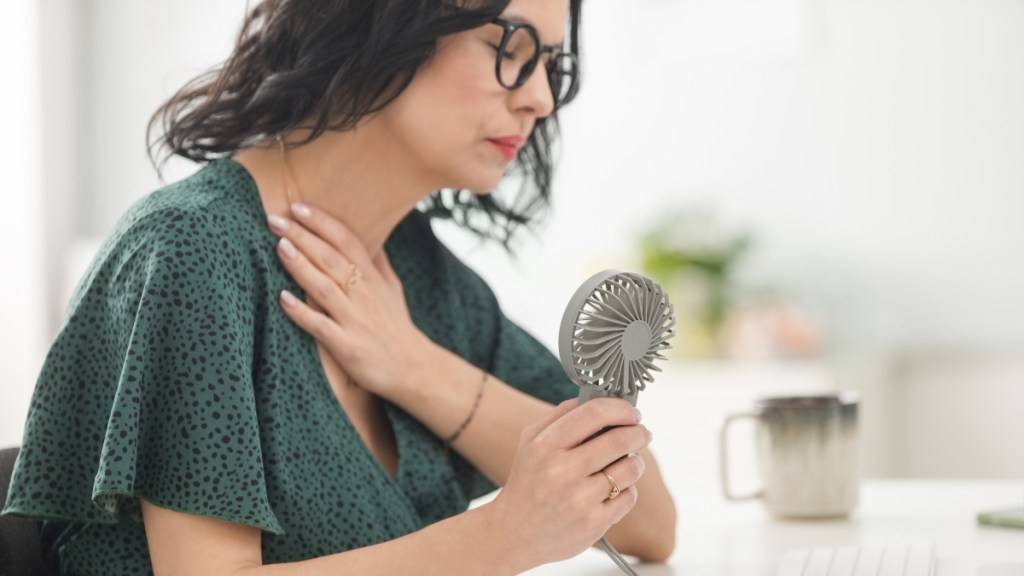
How yoga for menopause can help
Since menopause symptoms can last for years — even decades — getting them under control can make a world of difference in your everyday life. HRT can help, but it doesn’t always ease the mental toll menopause takes. That’s where yoga for menopause comes in.
“There is scientific evidence that menopause triggers changes in serotonin levels as well as dopamine — both neurotransmitters that greatly affect our mood and ability to sleep,” Dr. Jordan says. “The exercise, deep breathing and mind-body connection of yoga can increase serotonin and endorphin levels. This improves mood and reduces symptoms of depression and anxiety.”
In fact, researchers reporting in Brain, Behavior, and Immunity found that practicing yoga reduced the production of the stress hormone cortisol. And a review in Evidence-Based Complementary and Alternative Medicine found that yoga provided significant relief for the psychological symptoms of menopause, including depression and anxiety. (Click through for more ways to reduce cortisol.)
Similarly, Dr. Jordan says that yoga can reduce menopause-related inflammation and pain. It can also support a healthy metabolism, reducing the risk of weight gain and related health issues like high blood pressure and heart disease. (Click through to learn how to prevent osteoporosis that comes with menopause, too.)
Yoga for menopause is one tool in your toolkit
Petra Coveney, a professional yoga instructor and the author of Menopause Yoga: A Holistic Guide to Supporting Women on their Menopause Journey, says she’s witnessed the benefits of yoga for menopause first-hand. She’s found that women who practice yoga tend to experience fewer emotional highs and lows, so their menopause journey is more gentle.
That said, yoga for menopause isn’t a magic cure. “There’s a lot of nonsense out there,” Coveney says. “Yoga isn’t going to solve all of the symptoms and issues of women going through menopause. Neither is hormone replacement therapy, nutrition or exercise. Women need a holistic approach. A whole-person approach. And that can include yoga.” (Click through to learn how yoga eases knee pain, too.)
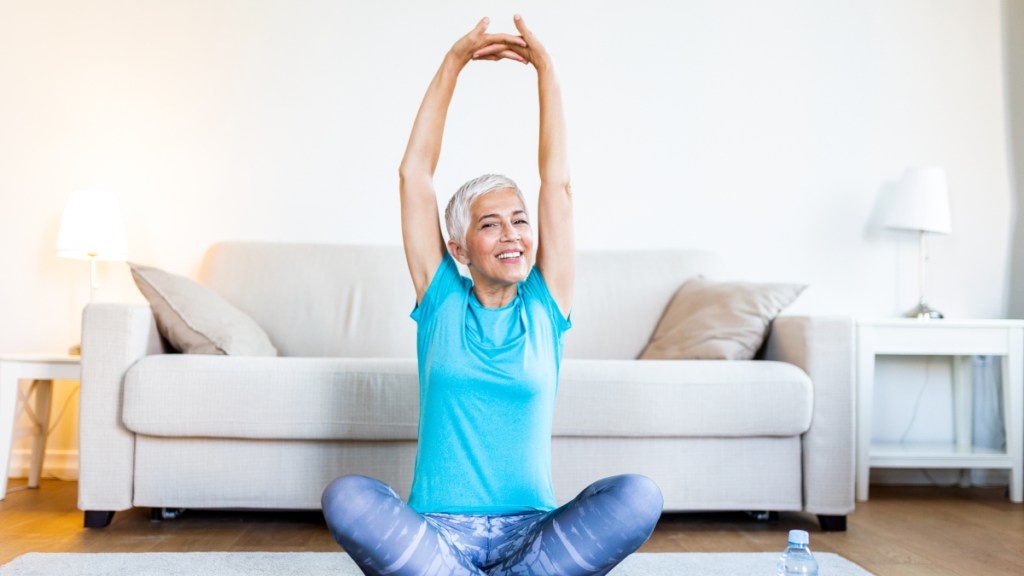
Yoga for menopause: 6 poses to try
In happy news, yoga for menopause is easy (even if you’re a beginner!) and it doesn’t require special equipment. These poses can be especially helpful for common menopause symptoms:
1. For irritability, Sa Na Ma Ta Meditation
Up to 70% of menopausal women report feelings of irritability. Luckily, a simple yoga meditation called Sa Ta Na Ma can help. Coveney says that saying these words out loud can “have a powerful effect on changing your nervous system” by minimizing feelings of anger. “Instead of exploding, you can practice this simple breathing technique for three or four rounds and you’ll notice that your hot emotions start to decrease,” she adds.
To do: “Take a deep breath in,” Coveney says. “As you exhale, touch your thumb to your index finger and whisper the word ‘sa’. Then, take another deep breath in. As you exhale, whisper ‘ta’ and touch your thumb to your middle finger.” Repeat the same steps, saying ‘na’ as you touch your ring finger and ‘ma’ as you touch your pinky. Repeat the sequence several times.
“If you don’t want to say the words out loud, you can say them in your mind,” Coveney says. “So long as you do it very slowly and with a long exhalation after each breath.” Check out the video below for a visual guide.
Related: Expert Help For a Little-Discussed But Common Menopause Symptom: Crankiness
2. For anxiety, Legs Raised on Chair
Anxiety and overwhelm affects up to half of perimenopausal and postmenopausal women, according to a report in the American Journal of Translational Research. Coveney says “when estrogen declines, it affects the brain’s ability to produce happy hormones, like serotonin, dopamine and oxytocin.” She compares this to how a car can’t function without working spark plugs. If one spark plug dies, the engine doesn’t work, similar to how a hormone imbalance can affect your mood.
Coveney’s recommendation: Relaxing with Viparita Karani, a yoga pose commonly called Legs Raised on Chair. “This yoga pose is really simple,” Coveney promises. (Click through to see more natural remedies for anxiety.)
To do: “Place a blanket on the floor and lie down in front of a wall or a piece of furniture, like an armchair or sofa,” Coveney says. “Then raise your legs and rest them on the wall, sofa or chair. If you feel cold, you can put a blanket over you. You might also want to place a scarf or eye mask over your eyes to block the light. Stay in this position for at least 10 minutes. Afterward, I promise you you’ll feel more rested” and relaxed. Check out the video below for a visual guide.
3. For hot flashes, Reclining Cobbler’s Pose
One reason yoga for menopause is effective is because it uses elements of cognitive behavioral therapy (CBT). CBT counseling focuses on the relationship between your thoughts, mood and behavior. In the case of yoga for menopause, it can help to change the way you think about discomforts like hot flashes.
Coveney says that when women feel embarrassed about hot flashes, their symptoms tend to last longer and be more severe. But when women accept that hot flashes are a normal part of menopause (and nothing to be embarrassed by), their symptoms fade faster. Indeed, a study in Menopause found that mindfulness training made coping with hot flashes easier. That’s why Coveney recommends the reclining cobbler’s pose, or Supta Baddha Konasana, for hot flash relief.
To do: Lie flat on your back on top of a rolled-up blanket or pillow. Bend your knees, then allow them to fall to the side. Extend your arms to your side, palms up. This pose “opens up your chest and armpits to release heat,” Coveney explains. “It’s the perfect exercise to do at home if you’re suffering from hot flashes.” Check out the video below for a visual guide.
Related: The 9 Best Foods That Fight Hot Flashes, According to MDs — No Medication Required
4. For fatigue, Menopause Warrior Chair Pose
If menopause is making you feel drained, Coveney recommends what she calls the menopause warrior chair pose (aka utkatasana). This pose “is basically a standing squat with lots of active movements,” she says. Squatting up and down boosts your heart rate and causes you to breathe more deeply, Coveney says. These motions increase circulation throughout your body, “clear brain fog, lift your mood, and help you feel more energized.”
To do: Stand straight with feet hip-width apart. “Bend your knees like you’re about to sit back into a chair,” Coveney says. Then ean slightly forward until your thighs make a 45-degree angle with the floor. Hold the position for 15-20 seconds. Then return to standing and repeat. Check out the video below for a visual guide.
5. For low self-esteem, Mountain Brook Pose
With all the mental, physical and emotional changes your body goes through during menopause, it’s no surprise that women report a loss of confidence. But mountain brook pose, which opens up your chest, helps restore your self-esteem.
“This stretch is really subtle, but so effective,” Coveney notes. “If you’re feeling that low mood, that low self-confidence, that ‘I’m not good enough’, this simple pose is perfect. It naturally stretches the muscles across your chest and opens up your lungs so you can breathe more deeply. When you come out of the pose, you feel lighter, and more uplifted.”
To do: Lie on your back and place a rolled-up blanket behind your shoulder blades so it slightly lifts your chest. Consider placing a body pillow or foam roller under your knees, too, to boost the benefit. Then place your arms out to the side, palms up, and breathe deeply. Check out the video below for a visual guide.
6. For joint pain, Cat-Cow Pose
More than 70% of menopausal women experience musculoskeletal pain during the menopause transition, according to research in Neural Plasticity. Here, too, yoga for menopause can help. While various yoga poses enahnce flexibility, professional yoga instructor Echo Wang suggests one in particular: Cat-cow. “Cat-cow is a gentle spine mobilization pose that promotes flexibility and eases joint aches,” she explains.
To do: Get down on the floor on all fours. Keep your arms shoulder-width apart and place your knees directly beneath your hips. Inhale deeply while lifting your head and allowing your spine to sink downward (like a cow). Then exhale deeply as you arch your spine upward and bring your head and pelvis down (like a cat). Repeat three or four times. Check out the video below for a visual guide.
Related: 13 Best Hand Massagers for Arthritis, Carpal Tunnel, and Stiff Joints
Yoga for menopause takes time
“The time it takes to experience relief varies,” Wang says. “Aim for a few minutes of daily practice, gradually increasing the duration as you feel more comfortable. Listen to your body and modify the poses as needed.”
Coveney adds that you should consult with your doctor before starting any new exercise program. Even though yoga is safe and usually well-tolerated, rushing into the practice could cause an injury.
Tip: For optimal results, Coveney recommends enrolling in yoga for menopause classes or working with an instructor specializing in menopause-specific techniques. Why? Certain types of yoga can exacerbate menopause symptoms. For example, Bikram or hot yoga, is practiced in a warm, humid room that can worsen hot flashes.
For more ways to ease menopause symptoms naturally:
Study: A Cold Plunge Eases Hot Flashes, Mood Swings + More Menopause Symptoms — How to Get the Perks
Seed Cycling Is the TikTok Trend That May Help Ease Menopause Symptoms Naturally
This content is not a substitute for professional medical advice or diagnosis. Always consult your physician before pursuing any treatment plan.






